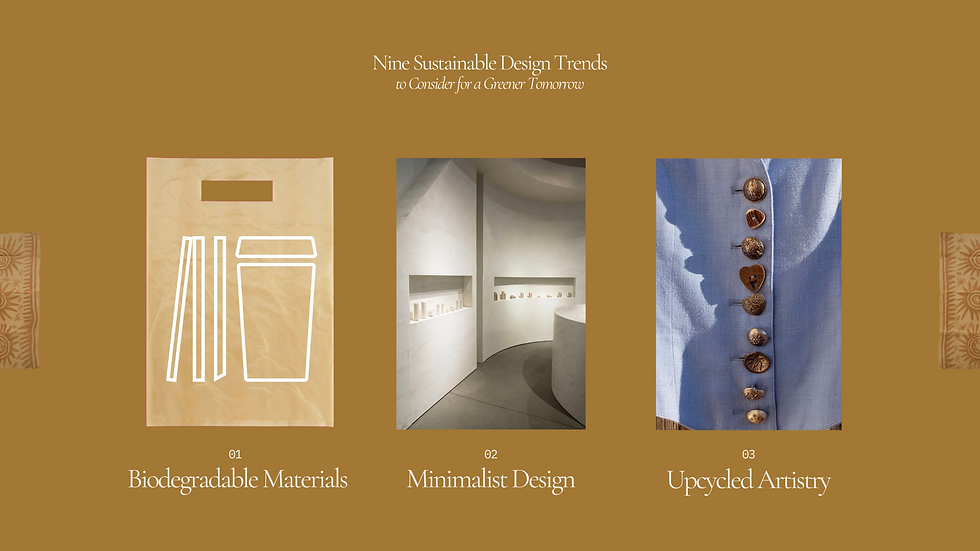Nine Sustainable Design Trends to Consider for a Greener Tomorrow
- Martin McBot

- Jan 19, 2024
- 2 min read
Updated: Jan 20, 2024
In an era where sustainability is no longer a choice but a necessity, the design world is swiftly adapting. As creatives, we should be at the forefront of these changes, shaping a future that's not just aesthetically pleasing but also environmentally responsible.

Incorporating sustainable design trends in branding, environmental, experiential, and graphic design is essential for creating a greener tomorrow. Here, we delve into nine sustainable design trends you can get inspired from, that are reshaping our world for a greener impact.

1. Biodegradable Materials: The New Norm
Gone are the days of single-use plastics and non-recyclable materials. Today's design landscape is embracing materials like bioplastics, organic fabrics, and sugarcane-based packaging. These materials decompose naturally, reducing landfill waste and our carbon footprint.
2. Minimalist Design
Adopting a minimalist approach reduces resource usage. In graphic and branding design, this can mean simpler, more efficient packaging and less ink usage.
3. Upcycled and Recycled Artistry
Upcycling is a movement that lived through a few years of trends. Designers are creatively repurposing old materials, giving them new life as furniture, clothing, and other products. This approach not only reduces waste but also adds unique history and character to each piece.

4. Digital-First Approach
Prioritizing digital media over print can significantly reduce paper and ink consumption. This is particularly relevant in graphic and branding design, where digital platforms are increasingly prevalent.
5. Sustainable Branding: More than just an Aesthetic
Brands are increasingly integrating sustainability into their identity. This can involve using sustainable practices in production and showcasing this commitment in the branding strategy.
6. Locally Sourced Materials
The carbon footprint of transporting materials across the globe is huge. By using locally sourced materials, designers reduce transportation emissions and support local economies, all while adding a touch of local flavor to their projects.

7. Biophilic Design
Incorporating natural elements into design, which is shown to improve mental health and well-being. This trend is especially relevant in environmental and experiential design, where the connection to nature can be made literal.
8. Zero-Waste Production Processes
Zero-waste design focuses on creating products with minimal to no waste. This approach challenges designers to rethink the lifecycle of their products, ensuring that every piece of material is used efficiently.
9. Digital Fabrication for Precision and Efficiency
Digital fabrication technologies like 3D printing are revolutionizing the design process. They allow for precise, efficient production, reducing material waste and enabling customization without the traditional manufacturing footprint.
By embracing these trends, designers can contribute to a more sustainable future, ensuring that their work not only meets the aesthetic and functional needs of today but also addresses the environmental challenges of tomorrow. Let's continue to innovate, inspire, and lead the way towards a greener tomorrow.


Comments